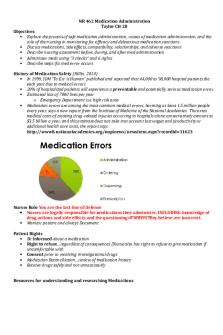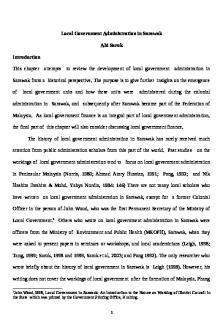Tuto 1 E-Tanah Administration System in Selangor PDF

| Title | Tuto 1 E-Tanah Administration System in Selangor |
|---|---|
| Author | Deeneshwaran Arumugam |
| Course | Land Law II |
| Institution | Universiti Kebangsaan Malaysia |
| Pages | 5 |
| File Size | 136.5 KB |
| File Type | |
| Total Downloads | 59 |
| Total Views | 194 |
Summary
E-Tanah adminstration system in Selangor...
Description
COURSE UUUK3043 LAND LAW II
TITLE TUTORIAL 1 THE E-TANAH REGISTRATION SYSTEM IN SELANGOR: ISSUES AND CHALLENGES
PREPARED BY NUR AISYAH BINTI EZAM (A168717) SITI AZURA GULAMRASUL (A170615) CHARMILAA A/P KRISHNAMOORTHI (A169684) DEENESHWARAN. A A/L V. ARUMUGAM (A162910) MUHAMMAD NOR AMIR BIN ABDULRAHMAN (A168978) WAN NURUL NASREEN BT. WAN MOHD NASIR (A168028)
PREPARED FOR PROF. MADYA DR. JADY @ ZAIDI HASSIM
1.0 Introduction (a) Historical Background of e-Tanah E-Tanah system is an Integrated Electronic Land Administration System which was developed for the purpose of improving land administrative procedures and processes in Malaysia for the benefit of the public. It consists of nine main modules, namely Registration, Revenue, Consent, Strata, Disposal, Acquisition, Development, Enforcement and Auction. It was developed based on the National Land Code 1965, and the Strata Title Act 1985 and State Rules & Other Acts and Enactments. The goal of e-Tanah is to establish a one-stop shop for land administration or commonly known as Single Point of Contact (SPOC). It was first used in Penang in October 2007 where 6 out of 9 of the modul (Registration, Revenue, Consent, Auction, Acquisition and Strata) was used full-cycle which is fully electronic and was then used in Negeri Sembilan and Melaka. In 2014, e-Tanah was approved by the Cabinet and 9 more states namely Wilayah Perseketuan, Kedah, Perlis, Perak, Selangor, Johor, Pahang, Kelantan and Terengganu which will use the system. (b) Legal Framework NLC 1965 expressly supports e-Tanah. Part 1 (c) section 5D of the NLC 1965 statutorily allows the Minister to modify the NLC 1965 so as to facilitate the implementation of e-Tanah. Online land administration (Fourteenth Schedule of NLC 1965) was also implemented alongside manual application of land registry. In 2005, e-Land Administration and the future i-Land system (Sixteenth Schedule of NLC 1965) was developed expeditiously. 2.0 Discussion (a) Issues The emerging Issues in computerised land admin system in Selangor is that it has yet to launch fully integrated and is still using step by step update in the system. This causes the need to go to different websites for different dealings, the public are also not used to an online system of land administration where they are still not familiar with the interface of the website, they don't know how to navigate around the website to perform certain dealings. There are problems in signing up and filling out the related forms. The e-payment system is also not completely established
through the website. This issue causes delays in taking actions on various applications received and also delays in decision making. The next issue on electronic land administration in Selangor is on fraud and forgery. Researchers have gathered evidence on fraud in land administration including those related to the electronic administration system. There were a few cases of land related fraud reported and the highest cases were spotted in the areas of which the land value is found very high. These types of fraud are identified and categorized as fraud by forgery, fraud by misrepresentation, fraud by alteration, fraud by hackers who compromise network and system and fraud by credit card payment. The type of cases involving fraud were related to the use of forms (Form 14A) in dealing with land registration for the purpose of changing ownership, the use of false title, identity and Sales and Purchase Agreement and the use of false Power of Attorney and Court Order. Such fraudulent activities took place when the administration system was handled by both manual and computerized registration systems. “A Fraudulent Land Transaction: The Case of Caesius Development Sdn Bhd (2020) 3 CLJ 32” is a case related to fraud in land transactions. This was an appeal brought by Pendaftar Hak Milik Negeri Selangor against Caesius Development Sdn Bhd & Others in a land related dispute. In this appeal, the land owner, Caesius Development Sdn Bhd was the plaintiff in the High Court matter who sued against the appellant. In the High Court, the plaintiff claimed for damages on the grounds that he was the true and sole registered owner of the land and that the change of name was fraudulently made. The plaintiff contended that the transfer of the land and the issuance of the computerized individual document of title (IDT) to the defendants were null and void. The High Court held that the land registration to the defendants were null and void as there was evidence of forged documents and fraudulent means of transfer. However, despite the finding, there was no evidence that the Plaintiff suffered any actual loss due to this fraudulent transaction, hence the plaintiff’s claim was dismissed for damages. (b) Challenges Despite having many payment options, one of the challenges faced by the users are lack of system maintenance. Users often find that the system gets stuck or down during the payment
check out process. Having many payment options in a system shall come with proper web maintenance and management as a large number of users use the system quite frequently. Compared to e-Tanah Terengganu which only offers 2 types of online payment method (Maybank2u and JOMpay), it doesn’t require constant website maintenance. Same goes to eTanah Perlis which only offers JOMpay as an online payment method, they do not require high website maintenance. Therefore, users from these states do not face glitch or system lag during payment check out due to the large number of users. Kiosk Different payment systems eases users in different ways. Although Selangor has one of the most updated and many payment methods, the lack of website maintenance always causes system lag for users. 3.0 Solution Administered in Selangor (a) Management and Administration of e-Tanah One of the solutions provided in the website to guide users through their services is by providing tutorials on how to use the system. In Selangor e-Hasil website, there is a “User Guide” section which provides users step-by-step infographic tutorials on how to check and pay their taxes through the website. The guide provided is written in simple and clear language which is easy to understand by less literate users. Another important feature available in the website to ensure that users can utilise the system is through the complaint and feedback section. Users who have the trouble in completing their transactions online have the option to fill out the complaint form and wait for a response from the web administrator. At the same time, other more user friendly platforms such as Facebook are used to supply information to the public in creating awareness of the available services provided in the website. However, there have not been any effective solutions to tackle other areas of the challenges including the e-payment system which still receives complaints from users and the unintegrated system which burden users to understand different methods of utilizing their services through different websites. For example, for tax-related services, users will be redirected to e-Hasil website.
(b) Legal Mechanism Part 1 (c) section 5D of the National Land Code 1965 statutorily allows the Minister to modify the Code so as to facilitate the implementation of e-Tanah. There, schedule fourteenth of National Land Code is applicable in matter concerning e-Tanah system and dealings executed through it. 4.0 Conclusion For the future direction of the e-Tanah system, some suggestions would include providing a clear, comprehensive and easy to follow video tutorial on how the users can navigate the website to encourage and smoothen the process of the e-Tanah system. Next, the e-Tanah system should look for a way for it to have a more user friendly interface. Finally, it should develop an integrated system by using only one website for all kinds of dealings, which would fit more of the goals of e-Tanah which is to make it a one-stop shop for land administration....
Similar Free PDFs

Tuto BCG - tuto
- 3 Pages

Equity Tuto Compilation 1
- 19 Pages

Tutorial 1 (MLS) - TUTO MLS
- 8 Pages

TUTO 435 for chapter 1
- 2 Pages

Test 1 Medication Administration
- 9 Pages

MLS Answer - TUTO MLS
- 79 Pages

Tuto 4 LAW434
- 4 Pages

W6 TUTO Implied Terms
- 2 Pages

Évaluation tuto 10 cheville
- 28 Pages

business maths tuto
- 1 Pages
Popular Institutions
- Tinajero National High School - Annex
- Politeknik Caltex Riau
- Yokohama City University
- SGT University
- University of Al-Qadisiyah
- Divine Word College of Vigan
- Techniek College Rotterdam
- Universidade de Santiago
- Universiti Teknologi MARA Cawangan Johor Kampus Pasir Gudang
- Poltekkes Kemenkes Yogyakarta
- Baguio City National High School
- Colegio san marcos
- preparatoria uno
- Centro de Bachillerato Tecnológico Industrial y de Servicios No. 107
- Dalian Maritime University
- Quang Trung Secondary School
- Colegio Tecnológico en Informática
- Corporación Regional de Educación Superior
- Grupo CEDVA
- Dar Al Uloom University
- Centro de Estudios Preuniversitarios de la Universidad Nacional de Ingeniería
- 上智大学
- Aakash International School, Nuna Majara
- San Felipe Neri Catholic School
- Kang Chiao International School - New Taipei City
- Misamis Occidental National High School
- Institución Educativa Escuela Normal Juan Ladrilleros
- Kolehiyo ng Pantukan
- Batanes State College
- Instituto Continental
- Sekolah Menengah Kejuruan Kesehatan Kaltara (Tarakan)
- Colegio de La Inmaculada Concepcion - Cebu





